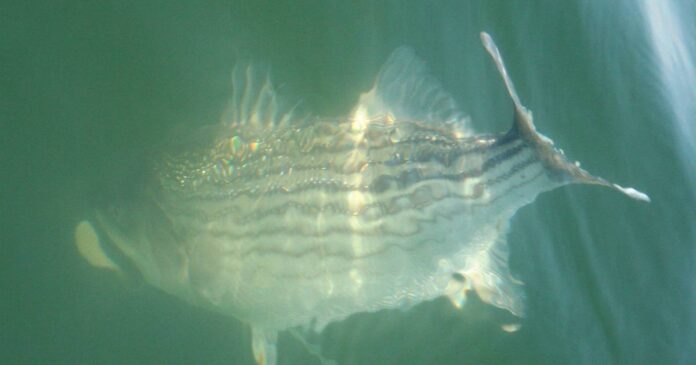A blustery late fall wind waylaid my fishing plans this week, but with any luck the weekend weather conditions will hold, giving me a chance look fair, just in time to catch a Thanksgiving rockfish. Weather windows are key right now, as is the willingness to cover water to find a good bite.
Meanwhile, here’s a bit of “Around the Horn” on fishing news.
No big surprises came out of last week’s Atlantic States Marine Fisheries Commission annual meeting. In fact, we heard a bit of good news on the current state of the striper stock. As the 2022 striper season winds down, anglers have reason to be cautiously optimistic that the population of this iconic sport fish is on a path toward recovery, but only if managers stay vigilant. Here’s my brief take.
The good news is that the most recent stock assessment found stripers (rockfish) are no longer being overfished. But the overall population of stripers is below the healthy target, although we’ve reduced the number of rockfish we’re killing.
No doubt this is encouraging news, but we’ve still got a long way to go before this iconic fishery returns to a level of health agreed to in the most recent striper management plan (Amendment 7). In a press release, chair of the ASMFC’s striper board, Marty Gary, put it accurately when he noted that “it is extremely important that we continue to monitor fishery removals and conduct regular stock assessments.” I’d go a step further. Let’s not just bank these conservation savings but accelerate them.
My ears also perked up when Maryland Department of Natural Resources fishery chief Mike Luisi chimed in at the ASMFC striper meeting. He asked, rhetorically I assumed, if cuts to harvest — almost all of which came from the recreational sector, mind you — seemed to be working. I had two reactions: 1. Good to hear confirmation that the plan is working, and 2. Why wouldn’t it? In the years long run-up to adopting Amendment 7, the road map to reverse the striper downturn, anglers urged, pleaded in fact, with fishery managers and natural resources leaders to tighten regulations, especially in Maryland. Had they done so earlier, arguably we’d be further along the track toward recovery.
That said, any attempt to handicap a striper rebuilding timetable — estimated to be seven to 10 years if all goes according to plan — must take into account these wild cards: stubbornly low juvenile abundance indices (also called young-of-the-year index) in Maryland’s portion of the Chesapeake, and impacts from climate change and invasive fish. Maryland’s JAI was again miserably soft in 2022, marking the fourth straight year Maryland Department of Natural Resources biologists registered an index that’s well below the long-term average of 11.3. In Virginia waters, encouragingly that number held steady, right around the long-term average of 7.77.
I’m keen to see who Governor-elect Wes Moore taps to lead DNR and the team that person assembles. Moore has promised to “aggressively protect our Chesapeake Bay.” Just about every sport angler I know would agree that that has not been the case with many of our public fisheries over the past several years. A new tide often brings better fishing. New leadership can often bring fresh thinking and invigorated action. Here’s hoping that’s the case in 2023. We shall soon see just how aggressive a Moore administration will be.
Based on a more favorable estimate of menhaden biomass, the ASMFC unanimously recommended to increase the coastwide harvest for this keystone forage fish by 20%. Yes, a bump was expected, but raising it by one-fifth seems unnecessarily risky. Northeast states and the lobster industry are driving this train, along with, you guessed it, Omega Protein.
Closer to home, two big menhaden meetings are on tap in Virginia. On Nov. 28, the state’s menhaden committee meets and on the agenda is an official response from the state’s Marine Resources Commission to the net spills this past summer. Sport anglers and Virginia’s Eastern Shore residents needn’t be reminded of the July debacles in which Omega Protein admitted to not one but two mishaps, the result of which was thousands of dead bunker strewn about Bay side beaches.
Worse yet, at least 12,000 pounds of red drum (roughly 300, according to VMRC) also died in the second incident. The majority of reds killed were trophy sized fish (up to 50 pounds) likely gorging on bunker to store up protein to spawn the next generation. There is no wanton waste law in Virginia (and as far as I know not in Maryland, either.) to hold the responsible party accountable when these types of commercial net spills occur. That needs to be addressed either via regulation or legislation.
At the Dec. 6 meeting, scores of people, representing recreational fishing and boating groups and regular citizens, will again ask Virginia to restrict industrial purse seine gear to ocean waters, effectively banning Omega from Chesapeake waters. Stay tuned.
Send iutdoors calendar listings and photos to cdollarchesapeake@gmail.com
Thru Feb. 28, 2023: CCA Maryland Pickerel Championship, a catch-photo-release tournament using the iAngler Tournament smartphone app. Register at ccamd.org.
Nov. 19: Free State Fly Fishers. 10 a.m.-Noon. Duber Winters and Joe Bruce will teach club members how to tie a handful of fly fishing knots. Davidsonville Family Recreation Center. Contact Ryan Harvey at rybeer@gmail.com.
Dec. 3: “Winter Classic” fishing tournament. Tall Timbers Marina. Register at ccamd.org/winter-classic.
Jan. 14, 2023: “Fishing Expo” from 8 a.m.-2 p.m. North Beach Volunteer Fire Department, 8536 Bayside Road, North Beach.
Jan. 20-22, 2023: 2nd Annual Chesapeake Bay Boat Show, State Fairgrounds, Timonium. Featuring more than thirty boat dealers, as well as tackle vendors. Details at thechesapeakebayboatshow.com.
Credit: Source link































